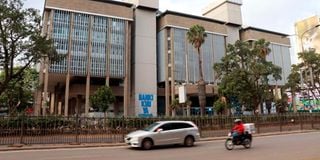Here’s what it takes to open and operate a bank business in Kenya

The Central Bank of Kenya headquarters in Nairobi.
I attended a training for boards of directors christened ‘Boards that Lead Programme’ in Istanbul, Turkey, the city that uniquely sits in two continents divided by the Bosphorus Strait. While there, I had a chance to interact with business leaders from all over the world.
One issue that most sought to understand was the requirements for opening and running a banking operation in Kenya. One of the most unique sectors to set up an enterprise in is the banking system. Stringent requirements run through the licensing stage, establishment and the continuous observance of regulatory standards.
From the outset, an applicant seeking to open a bank must have the word ‘bank’ in the proposed name. One must also propose directors and the chief executive officer of the business, who together with other key shareholders must undergo a ‘fit and proper’ assessment by the Central Bank of Kenya (CBK).
The applicant must also submit a feasibility study of its future operations and development covering a minimum of three years from the date of application, besides providing a detailed account of its intended sources and evidence of availability of capital. At the moment, the minimum core capital stands at Sh1 billion.
Once these requirements are met, the CBK grants an approval in principle for the applicant to conduct the business of a bank. The applicant is then required to obtain premises, set up information technology systems and put in place other operating facilities as well as recruit staff.
Licence fees
Upon executing these, the CBK is again invited to conduct an inspection which, if satisfactory, the applicant proceeds to pay licence fees. The CBK specifies the institution via a publication in the Kenya Gazette, and then issues a licence. On getting a licence, the bank is required to pay Sh400,000 – an annual payment that is due at each anniversary of the bank.
In the course of setting up, the applicant faces heavy sunk costs related to the procurement of information systems and the set-up of premises to meet certain CBK minimum standards. These standards include burglar proofing the premises and ensuring the premises and branches are in secure sites. The total cost of establishing a bank branch is estimated to range between Sh30 million and Sh50 million, depending on its size and location. Branches are in most cases located along the most expensive streets in a town.
Annual branch licence fees range from Sh30,000 to Sh150,000, depending on whether the branch is in an urban centre, town, or a municipality. In addition, banks have to install back-up power generators to support operations due to intermittent power outages on the national grid.
At the operational level, there is a continuous need for banks to meet well-stipulated regulatory requirements, as well as ensure alignment to global best practices. In Kenya, commercial banks are licensed and regulated in accordance with the provisions of the Banking Act, which underpin the Prudential Guidelines.
Soundness and stability
Banks are subject to regulatory requirements governing their prudential position and market conduct in order to safeguard the overall soundness and stability of the financial system. To this end, banks must always be in close contact with and supply financial operational data to the CBK.
The specific data – supplied on a monthly and quarterly basis – help monitor observance of core and total capital ratios as an assessment of the adequacy of capital, liquidity ratios and adherence to the requirements of the International Financial Reporting Standards (IFRS) that benchmark their operations to global best practice.
Banks are by law required to continuously ensure that their core capital and total capital are at a minimum of 10.5 per cent and 14.5 per cent of the total risk-weighted assets, respectively. In addition, short-term liquid assets must be able to meet at least 20 per cent of the bank’s short-term /maturing liabilities. With respect to observance of IFRS 9 requirements, banks have to make additional general provisions for loans extended as they transition from performing to non-performing loans and ensure that they are fully provided for by the time they are declared doubtful.
Additionally, banks must insure all the customer deposits with the Kenya Deposit Insurance Corporation as well as meet the Cash Reserve Requirements (CRR) on deposits. The costs associated with deposit insurance premiums are assessed based on an overall risk assessment of a bank in line with its capital adequacy, asset quality, management quality, earnings ability and liquidity. Operationally, this compels banks to be more stringent in their origination of assets, while also ensuring that all investment undertakings supply a positive return. As an additional foregone income related to maintaining customer deposits, banks have to deposit 4.25 percent of its total deposits with CBK towards meeting the regulatory CRR requirements. These funds are not available to generate any income for the bank and by extension depositors.
Upon assessing the breadth of requirements that a bank faces from its inception running through its operations, the question is, would shareholders of a bank accommodate a financial report announcing losses after all these?
In addition, as suppliers of the ‘oil that lubricates the economic engine’, banks must be well placed as the ‘big brother’ industry with some reasonable level of profitability.
Just as it is celebrated when, say, manufacturing grows, the oil that lubricates the engines under manufacturing is the cash committed by banks – amidst the costs and requirements- to finance the growth. When banks grow, this outcome places them at a better position to effectively serve the rest of the economy, including providing support to the national goals of financial inclusion of previously underserved segments.
Dr Habil Olaka is the CEO of Kenya Bankers Association.





